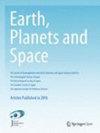赤道等离子体气泡壁上由于与午夜亮度波的相互作用而产生的二次不稳定性
IF 2.5
3区 地球科学
引用次数: 0
摘要
在born Jesus da Lapa(13.3°S, 43.5°W)上空观测了赤道等离子体气泡(EPBs)与午夜亮度波(MBW)的相互作用;准偶极地磁纬度14.1°S),使用OI 630 nm全天图像。在2019年12月22日晚上,人们看到一只EPB在化石阶段向东传播,直到它与MBW相互作用。相互作用后,epb的西壁产生了与梯度漂移不稳定性(GDI)和/或开尔文-亥姆霍兹不稳定性(KHI)相关的二次不稳定性。我们认为,由于热层动力学的变化,例如F层高度的中性风,MBW有助于在epb壁上产生切变。此外,对全天图像的光谱分析表明,GDI和/或KHI产生了湍流,并有助于消散epb。图形抽象本文章由计算机程序翻译,如有差异,请以英文原文为准。
Secondary instability generated on the equatorial plasma bubbles wall due to an interaction with midnight brightness wave
Abstract Interaction between Equatorial Plasma Bubbles (EPBs) and midnight Brightness wave (MBW) was observed over Bom Jesus da Lapa (13.3° S, 43.5° W; Quasi-Dipole geomagnetic latitude of 14.1° S), using OI 630 nm all-sky images. On the night of December 22nd, 2019, an EPB was seen propagating eastward in its fossil stage until it interacted with an MBW. After the interaction, the west walls of EPBs generated secondary instabilities that can be associated with gradient drift instability (GDI) and/or Kelvin–Helmholtz instabilities (KHI). We suggest that the MBW contributed to generate a shear in the EPBs walls due to changes in the thermospheric dynamics, such as neutral wind in the F layer height. Furthermore, spectral analysis of the all-sky images suggests that GDI and/or KHI generated turbulence and helped to dissipate the EPBs. Graphical Abstract
求助全文
通过发布文献求助,成功后即可免费获取论文全文。
去求助
来源期刊

Earth, Planets and Space
地学天文-地球科学综合
CiteScore
5.80
自引率
16.70%
发文量
167
期刊介绍:
Earth, Planets and Space (EPS) covers scientific articles in Earth and Planetary Sciences, particularly geomagnetism, aeronomy, space science, seismology, volcanology, geodesy, and planetary science. EPS also welcomes articles in new and interdisciplinary subjects, including instrumentations. Only new and original contents will be accepted for publication.
 求助内容:
求助内容: 应助结果提醒方式:
应助结果提醒方式:


